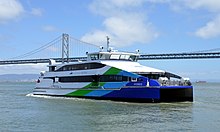
AC Transit is an Oakland-based public transit agency serving the western portions of Alameda and Contra Costa counties in the East Bay of the San Francisco Bay Area. AC Transit also operates "Transbay" routes across San Francisco Bay to San Francisco and selected areas in San Mateo and Santa Clara counties. AC Transit is constituted as a special district under California law. It is governed by seven elected members. It is not a part of or under the control of Alameda or Contra Costa counties or any local jurisdictions.
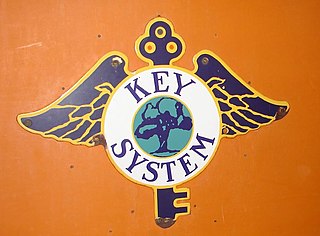
The Key System was a privately owned company that provided mass transit in the cities of Oakland, Berkeley, Alameda, Emeryville, Piedmont, San Leandro, Richmond, Albany, and El Cerrito in the eastern San Francisco Bay Area from 1903 until 1960, when it was sold to a newly formed public agency, AC Transit. The Key System consisted of local streetcar and bus lines in the East Bay, and commuter rail and bus lines connecting the East Bay to San Francisco by a ferry pier on San Francisco Bay, later via the lower deck of the Bay Bridge. At its height during the 1940s, the Key System had over 66 miles (106 km) of track. The local streetcars were discontinued in 1948 and the commuter trains to San Francisco were discontinued in 1958. The Key System's territory is today served by BART and AC Transit bus service.
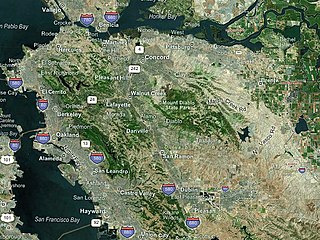

Golden Gate Transit (GGT) is a public transportation system serving the North Bay region of the San Francisco Bay Area in California, United States. It primarily serves Marin County, Sonoma County, and San Francisco, and also provides limited service to Contra Costa County. In 2022, Golden Gate Transit had a ridership of 1,205,100, or about 4,300 per weekday as of the second quarter of 2023.

The San Francisco Ferry Building is a terminal for ferries that travel across the San Francisco Bay, a food hall and an office building. It is located on The Embarcadero in San Francisco, California and is served by Golden Gate Ferry and San Francisco Bay Ferry routes.

Richmond station is an Amtrak intercity rail and Bay Area Rapid Transit (BART) station located in downtown Richmond, California. Richmond is the north terminus of BART service on the Orange Line and Red Line; it is a stop for Amtrak's Capitol Corridor, San Joaquins, and California Zephyr routes. The accessible station has one island platform for the two BART tracks, with a second island platform serving two of the three tracks of the Union Pacific Railroad Martinez Subdivision for Amtrak trains. It is one of two transfer points between BART and Amtrak, along with Oakland Coliseum station.

People in the San Francisco Bay Area rely on a complex multimodal transportation infrastructure consisting of roads, bridges, highways, rail, tunnels, airports, seaports, and bike and pedestrian paths. The development, maintenance, and operation of these different modes of transportation are overseen by various agencies, including the California Department of Transportation (Caltrans), the Association of Bay Area Governments, San Francisco Municipal Transportation Agency, and the Metropolitan Transportation Commission. These and other organizations collectively manage several interstate highways and state routes, eight passenger rail networks, eight trans-bay bridges, transbay ferry service, local and transbay bus service, three international airports, and an extensive network of roads, tunnels, and bike paths.
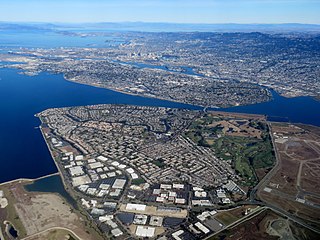
Bay Farm Island is a district of the city of Alameda, California, though it is separated from the rest of the city on Alameda Island by an estuary of San Leandro Bay. Its ZIP code is 94502. The location was originally an island in San Francisco Bay, but due to land reclamation it has become a peninsula and is now connected to the mainland of Oakland and Oakland International Airport. Marshes and other areas of the island were also reclaimed.

San Francisco Bay in California has been served by ferries of all types for over 150 years. John Reed established a sailboat ferry service in 1826. Although the construction of the Golden Gate Bridge and the San Francisco–Oakland Bay Bridge led to the decline in the importance of most ferries, some are still in use today for both commuters and tourists.

Blue & Gold Fleet is a privately owned company in the United States providing ferry services in the San Francisco Bay Area of California. It operates the San Francisco Bay Ferry commuter ferry system under contract with WETA. Blue & Gold also operates tourist and excursion services under its own brand from Pier 41 in San Francisco, with midday ferry service to Sausalito and a variety of tourist routes. The company is the Bay Area's largest ferry transportation provider and carries approximately 4 million passengers annually.

Golden Gate Ferry is a commuter ferry service operated by the Golden Gate Bridge, Highway and Transportation District in San Francisco Bay, part of the Bay Area of Northern California, United States. Regular service is run to the Ferry Building in San Francisco from Larkspur, Sausalito, Tiburon, and Angel Island in Marin County, with additional service from Larkspur to Oracle Park and Chase Center. The ferry service is funded primarily by passenger fares and Golden Gate Bridge tolls. In 2022, Golden Gate Ferry had a ridership of 1,022,800, or about 4,200 per weekday as of the second quarter of 2023.

Richmond Ferry Terminal is a ferry terminal located in the Marina Bay neighborhood of Richmond, California. It provides daily commuter service to San Francisco.
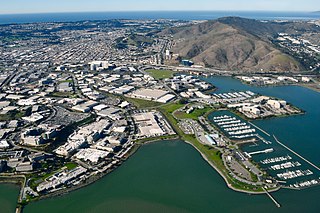
Oyster Point Marina/Park is a 408-berth public marina and 33-acre (13 ha) park located in the city of South San Francisco, California on the western shoreline of San Francisco Bay.

The Vallejo Station was created by combining the Vallejo Ferry Terminal, the Vallejo Transit Center bus station, and a connecting multi-story parking garage and paseo. It is designed to be an inter-modal transit station in Vallejo, California. It is located in the western part of Central Vallejo.

Hercules station is a proposed intermodal infill train station and ferry terminal in Hercules, California in Contra Costa County. It is to be the first direct Amtrak-to-ferry transit hub in the San Francisco Bay Area and will be constructed in between the existing Richmond and Martinez stations. By July 2018, three of the station's six construction phases had been complete, including street at Bay Trail approaches.

The Richmond–San Rafael Ferry Company was a ferry service between Castro Point in Richmond in Contra Costa County and San Quentin in Marin County, California across the San Pablo Bay. It ran from 1915 until the 1956 opening of the Richmond–San Rafael Bridge.

SolTrans, officially Solano County Transit, is a Joint Powers Authority that provides public transportation service to the southern Solano County cities of Vallejo and Benicia. SolTrans was established in 2011 and is the result of a merger between Vallejo Transit and Benicia Breeze. In 2022, the system had a ridership of 750,700, or about 200 per weekday as of the second quarter of 2023.

The Oakland Ferry Terminal is a ferry terminal on the San Francisco Bay, located in Jack London Square in Oakland, California.

The South San Francisco Ferry Terminal is the only operating ferry terminal in San Mateo County, California. Boats are operated by San Francisco Bay Ferry and connect the city of South San Francisco to the Oakland Ferry Terminal in Jack London Square as well as Alameda, California. Construction began in 2009 and ferry service started on June 4, 2012. While ferry service between San Francisco and ports to the south existed as far south as San Jose/Alviso during the 1800s, most passengers to Peninsula destinations took the San Francisco and San Jose Railroad after it was completed in 1864 as part of the transcontinental railway.
